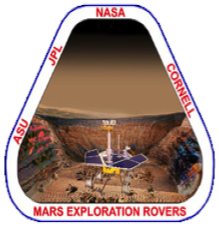
DERIVED DATA SET UNDER CONSTRUCTION
The Mini-TES is a Fourier Transform Spectrometer covering the spectral range 5-29μ (339.50 to 1997.06 cm-1) with a spectral sample interval of 9.99 cm-1. The instrument is located at the bottom of the rover's mast, and scanning mirrors reflect light down to it: thus, it sees the terrain or sky from the same vantage point as PanCam.
Atmospheric observations
Temperature Profiles - Mini-TES has been pointed upward to 30 deg. above the horizon. Using temperatures retrieved from the wings of the 15-mm CO2 band, this upward-viewing mode yields high-resolution temperature profiles through the bottom few km of the atmosphere. This lowest region of the atmosphere has been difficult to measure on Mars because of the nature of the weighting functions as seen from orbit, and because of the difficulty of determining surface contributions to radiance.
Water abundance - Water vapor abundance was obtained from rotational H2O lines. Separate measurements of water near the ground were obtained by viewing distant surface obstacles. The broad water-ice feature centered near 800 cm^-1 allowed monitoring of ground ice hazes. Together, these measurements will illuminate the behavior of water in lower atmosphere and of water transport between the atmosphere and surface.
Atmospheric dust abundance was obtained using the redundant temperature information in both sides of the 15 mm CO2 band, together with differential absorption across the dust band in that region.
The Data Description - TBD
Retrieving the Data Volume - TBD
Raw Data - TBD
Derived Data - TBD
CITATION_DESC = Christensen, P, MER 2 Mars Mini-TES BTR V1.0, NASA Planetary Data System, MER2-M-MTES-4-BTR-V1.0, 2004.
Derived Data CITATION_DESC = TBD
Related data from other missions- TBD
Atmospheric observations
Temperature Profiles - Mini-TES has been pointed upward to 30 deg. above the horizon. Using temperatures retrieved from the wings of the 15-mm CO2 band, this upward-viewing mode yields high-resolution temperature profiles through the bottom few km of the atmosphere. This lowest region of the atmosphere has been difficult to measure on Mars because of the nature of the weighting functions as seen from orbit, and because of the difficulty of determining surface contributions to radiance.
Water abundance - Water vapor abundance was obtained from rotational H2O lines. Separate measurements of water near the ground were obtained by viewing distant surface obstacles. The broad water-ice feature centered near 800 cm^-1 allowed monitoring of ground ice hazes. Together, these measurements will illuminate the behavior of water in lower atmosphere and of water transport between the atmosphere and surface.
Atmospheric dust abundance was obtained using the redundant temperature information in both sides of the 15 mm CO2 band, together with differential absorption across the dust band in that region.
Useful Mission Documents
Description of the data volume
Mission Description
Spacecraft Description
Instrument Description
Generation of derived data TBD
Mission Description
Spacecraft Description
Instrument Description
Generation of derived data TBD
The Data Description - TBD
Retrieving the Data Volume - TBD
Raw Data - TBD
Derived Data - TBD
CITATION_DESC = Christensen, P, MER 2 Mars Mini-TES BTR V1.0, NASA Planetary Data System, MER2-M-MTES-4-BTR-V1.0, 2004.
Derived Data CITATION_DESC = TBD
Related data from other missions- TBD
 PDS: The Planetary Atmospheres Node
PDS: The Planetary Atmospheres Node

